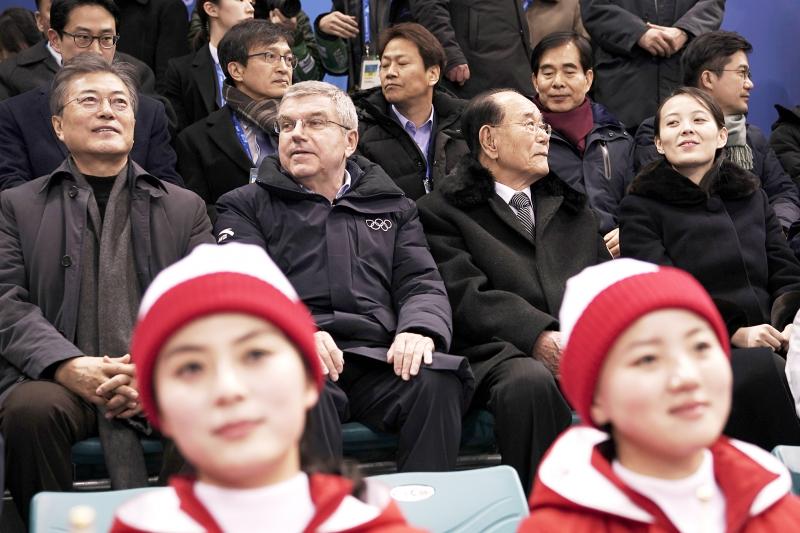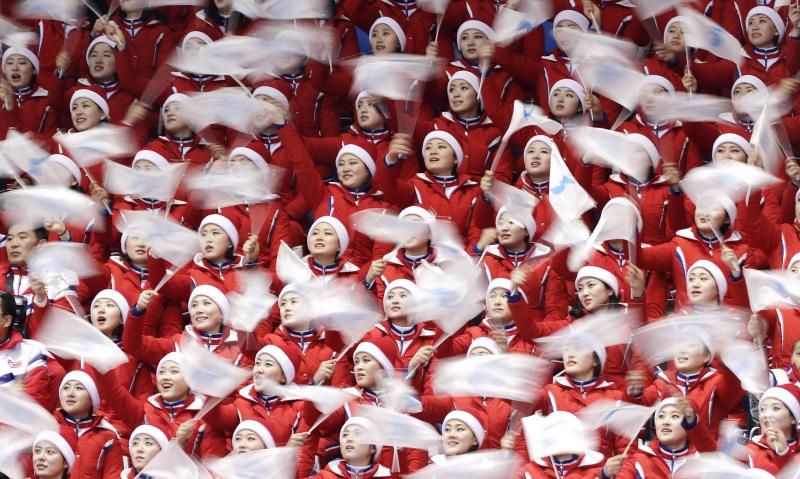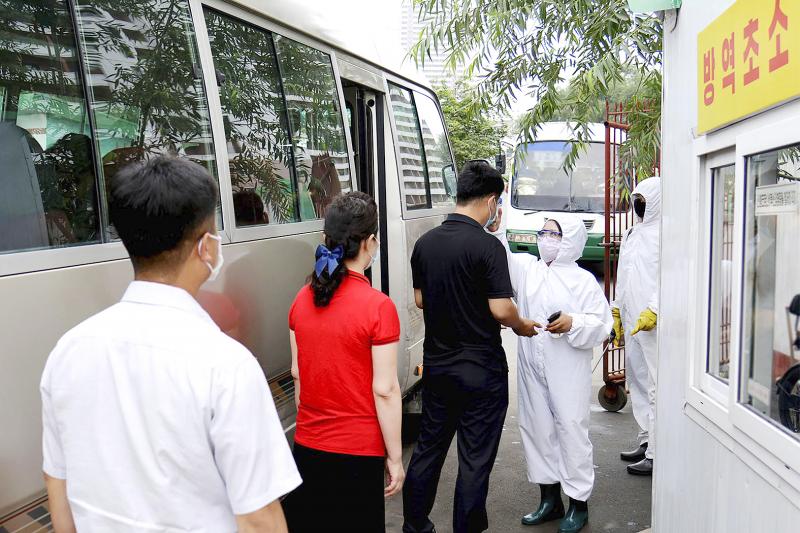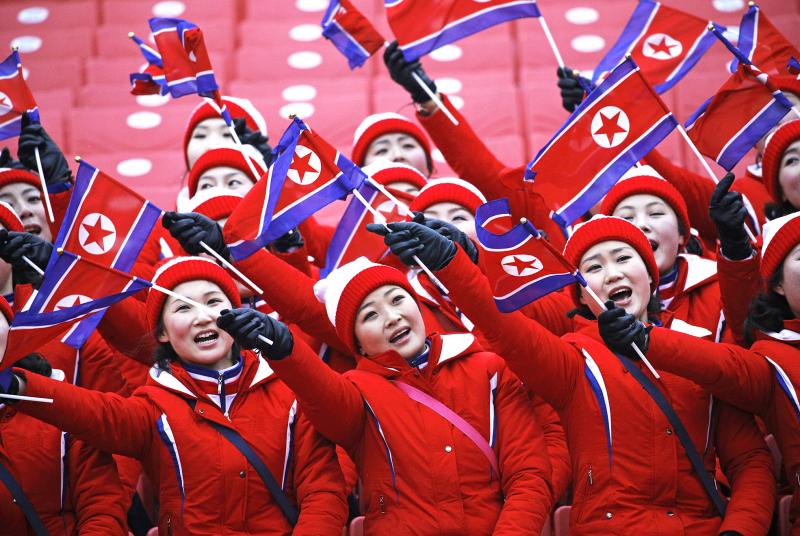North Korea isn’t at the Tokyo Olympics this summer. And therein lies a tale — one of sports and viruses, but most of all a tale of complex politics.
While it’s not making headlines here, the North’s absence is noteworthy, especially among those who watch the intersection of sports and diplomacy — and the way North Korea’s propaganda machine uses international attention to advance its needs.
The no-show is especially striking when contrasted with the last Games. Perhaps the hottest story of the 2018 Winter Olympics in Pyeongchang, South Korea, was the North Korean delegation, which included 22 athletes, hundreds of cheerleaders and leader Kim Jong-un’s powerful sister.

Photo: AP
The coronavirus is the biggest reason for North Korea’s decision not to come to Tokyo. Always highly sensitive to communicable disease outbreaks, the nation has shut its borders even more tightly than normal, worried that its fragile health care system and rickety economy could not withstand a major outbreak. That, in turn, could imperil the ruling Kim family’s grip on power.
But there are other things at work, too, according to analysts.
North Korean sports, like much about the country, are intertwined with calculations about its pursuit of a nuclear-armed long-range missile program to target the US mainland. After a brief period of engagement, Kim Jong-un now fears the introduction of another virus — the cultural one from the wealthy South — and may be biding his time until next year’s Winter Games. Those take place in China, its longtime ally with which it shares a land border.

Photo: AP
Kim may have also decided there’s nothing to be gained by nuclear diplomacy at the Tokyo games, as Washington shows no intention of accepting Pyongyang’s demand to end sanctions.
PROPAGANDA
Neither do sports exist in a void inside the North, where domestic audiences consume messages controlled by the government every step of the way. Everything there is potential fodder for the propaganda mavens who try to maintain domestic unity and regime loyalty.

Phots: AP
Kim Jong-un may use the North’s absence from the Tokyo Games as a way to signal to his people that he values protecting them from the coronavirus — in rival Japan, no less — more than the possible glory his athletes could have enjoyed.
“North Korea excels in propaganda at international sport events,” said Sung-Yoon Lee, a Korean studies professor at the Fletcher School at Tufts University in Massachusetts.
So it was likely a tough decision for North Korea not to attend the Tokyo Games, “which it could have dominated in the propaganda field by sending a few athletes, cheerleaders and First Sister Kim Yo-jong,” Lee said, referring to the leader’s sister, Kim Yo-jong.

Photo: AP
Missing a chance to score propaganda points “reflects some serious COVID paranoia,” Joshua Pollack, a North Korea expert at the Middlebury Institute of International Studies at Monterey, said of the North’s decision not to attend. The country clearly isn’t ready for the delta variant, he says, “and the Olympic village seems like a great way to bring it home.”
September brought a vivid example of North Korea’s virus fears. Seoul accused the North of fatally shooting a South Korean fishery official found in the North’s waters and then burning his body — moves apparently in line with an anti-virus policy that involves shooting anyone crossing the border illegally.
“They don’t have medicines to cure COVID-19, their medical infrastructure isn’t in good shape and they’re not receiving vaccines,” said Kim Yeol-soo, an analyst with South Korea’s Korea Institute for Military Affairs. “So they might not think that going to the Olympics and winning a couple of gold medals means that much.”
GEOPOLITICS
Geopolitical considerations might also be at play. Unlike the 2018 Pyeongchang Games, where North Korea was deeply interested in reaching hearts and minds in the South, there is no such desire to make nice with Japan, which was the violent colonial overlord of the Korean Peninsula before and during World War II.
At Pyeongchang, North Korea had no real medal contenders, but it was among the most watched nations at the Games, with a huge delegation highlighted by a 229-member all-female cheering squad.
After months of US-North Korean tensions ahead of those Games, athletes from both Koreas marched together into the Olympic Stadium below a “unification” flag. They fielded a joint women’s ice hockey team. And Kim Yo-Jong made the first-ever visit to the South by a member of the Kim dynasty since the end of the 1950-53 Korean War.
Diplomacy blossomed after these Games, too, highlighted by several summits between then-US president Donald Trump and Kim Jong-un, and also by Kim and South Korean President Moon Jae-in.
Not much came of it, however, and North Korea still faces the hardline sanctions that are crippling its economy. So it has since engaged little with its rivals, though this week the Koreas restored suspended communication channels and agreed to improve ties.
When North Korea does show up at the Olympics, sports often take a back seat to politics. The nation goes to great lengths to control its athletes and its message, but there are still surprising, unscripted moments of contact with other athletes. At Pyeongchang, for instance, a selfie taken by smiling North and South Korean skaters went viral online.
And what about sports themselves? North Korea could have seen success at Tokyo in weightlifting, boxing, women’s wrestling and women’s marathon. Fears, however, seem to have outweighed the perceived benefits.
NORTH VS SOUTH
Those include worries about outside influences, especially South Korean culture, infiltrating the country.
“The contrast between the prosperous South and the struggling North is that much less palatable these days,” Pollack said.
Some expect North Korea to emerge again from its self-imposed lockdown next year when China, a key political and aid lifeline, hosts the Winter Games.
If past behavior is an indication, weapons tests might take place in the months before those Games. While the North will likely avoid anything considered a provocation during the Tokyo Games, such tests could come when US and South Korean soldiers conduct their annual military drills next month.
“Confrontation followed by dialogue always works best” for North Korea, said Lee, the Tufts professor. “I expect the regime to increase its ‘net value’ — as top athletes do in international sport competition — with a superb performance, of the martial kind, before the Beijing Winter Games.”
Steven Crook’s column Highways and Byways will return to this space next week.

May 26 to June 1 When the Qing Dynasty first took control over many parts of Taiwan in 1684, it roughly continued the Kingdom of Tungning’s administrative borders (see below), setting up one prefecture and three counties. The actual area of control covered today’s Chiayi, Tainan and Kaohsiung. The administrative center was in Taiwan Prefecture, in today’s Tainan. But as Han settlement expanded and due to rebellions and other international incidents, the administrative units became more complex. By the time Taiwan became a province of the Qing in 1887, there were three prefectures, eleven counties, three subprefectures and one directly-administered prefecture, with

It’s an enormous dome of colorful glass, something between the Sistine Chapel and a Marc Chagall fresco. And yet, it’s just a subway station. Formosa Boulevard is the heart of Kaohsiung’s mass transit system. In metro terms, it’s modest: the only transfer station in a network with just two lines. But it’s a landmark nonetheless: a civic space that serves as much more than a point of transit. On a hot Sunday, the corridors and vast halls are filled with a market selling everything from second-hand clothes to toys and house decorations. It’s just one of the many events the station hosts,

Among Thailand’s Chinese Nationalist Party (KMT) villages, a certain rivalry exists between Arunothai, the largest of these villages, and Mae Salong, which is currently the most prosperous. Historically, the rivalry stems from a split in KMT military factions in the early 1960s, which divided command and opium territories after Chiang Kai-shek (蔣介石) cut off open support in 1961 due to international pressure (see part two, “The KMT opium lords of the Golden Triangle,” on May 20). But today this rivalry manifests as a different kind of split, with Arunothai leading a pro-China faction and Mae Salong staunchly aligned to Taiwan.

Two moves show Taichung Mayor Lu Shiow-yen (盧秀燕) is gunning for Chinese Nationalist Party (KMT) party chair and the 2028 presidential election. Technically, these are not yet “officially” official, but by the rules of Taiwan politics, she is now on the dance floor. Earlier this month Lu confirmed in an interview in Japan’s Nikkei that she was considering running for KMT chair. This is not new news, but according to reports from her camp she previously was still considering the case for and against running. By choosing a respected, international news outlet, she declared it to the world. While the outside world